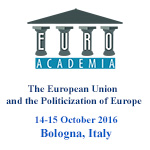Euroacademia Conferences
 Europe Inside-Out: Europe and Europeanness Exposed to Plural Observers (9th Edition) April 24 - 25, 2020
Europe Inside-Out: Europe and Europeanness Exposed to Plural Observers (9th Edition) April 24 - 25, 2020 Identities and Identifications: Politicized Uses of Collective Identities (9th Edition) June 12 - 13, 2020
Identities and Identifications: Politicized Uses of Collective Identities (9th Edition) June 12 - 13, 2020 8th Forum of Critical Studies: Asking Big Questions Again January 24 - 25, 2020
8th Forum of Critical Studies: Asking Big Questions Again January 24 - 25, 2020 Re-Inventing Eastern Europe (7th Edition) December 13 - 14, 2019
Re-Inventing Eastern Europe (7th Edition) December 13 - 14, 2019 The European Union and the Politicization of Europe (8th Edition) October 25 - 26, 2019
The European Union and the Politicization of Europe (8th Edition) October 25 - 26, 2019 Identities and Identifications: Politicized Uses of Collective Identities (8th Edition) June 28 - 29, 2019
Identities and Identifications: Politicized Uses of Collective Identities (8th Edition) June 28 - 29, 2019 The European Union and the Politicization of Europe (7th Edition) January 25 - 26, 2019
The European Union and the Politicization of Europe (7th Edition) January 25 - 26, 2019 7th Forum of Critical Studies: Asking Big Questions Again November 23 - 24, 2018
7th Forum of Critical Studies: Asking Big Questions Again November 23 - 24, 2018 Europe Inside-Out: Europe and Europeanness Exposed to Plural Observers (8th Edition) September 28 - 30, 2018
Europe Inside-Out: Europe and Europeanness Exposed to Plural Observers (8th Edition) September 28 - 30, 2018 Identities and Identifications: Politicized Uses of Collective Identities (7th Edition) June 14 - 15, 2018
Identities and Identifications: Politicized Uses of Collective Identities (7th Edition) June 14 - 15, 2018
“Le tenebroso est à la mode”. The Prado Museum and the Italian Baroque Exhibitions in the Economic Golden Age of Western Europe
-
-

-
Presentation speakers
- Patricia García-Montón González, Universidad Complutense de Madrid, Spain
Abstract:
The Europe of the 1950s was the perfect setting to promote the revaluation of Seicento Italian Painting. Thanks of the economic recovery after the Second War World, many exhibitions were held in Italy with the aim of seducing the critics and looking to attract the general public attention towards this art. Despite the enthusiasm shown by other European collections, the Prado Museum didn’t take part. It continued defending its policy of not lending artworks for conservation reasons. But this matter also bothered the ICOM since long time ago, though it was especially relevant the report that René Huyghe, chief curator of the Louvre, presented in London in 1950 due to the alarming growth of temporary exhibitions. But in 1957 Europe would live a very important moment for its unification: the signing of the Treaty of Rome which established the new EEC. And the best way to celebrate it was with an exhibition à la mode about Il Seicento europeo. This mostra pointed a new geographic dimension in the historiography: beyond the construction of national histories of art was gradually forged a new history about an artistic Europe with a coherent identity. But Spain –and therefore the Prado– was a resounding absence. “Spain is different!” announced the famous slogan which at the beginning of the 1960s popularized by the new reformist government of Franco in order to promote foreign tourism. The Prado joined to this progressive openness, besides to the boom of exhibitions of the hedonistic Western society born in the Trente Glorieuses and to the inexorable appreciation of Seicento painting. The museum gave up its loans policy and this involved a turning point in the construction of the Spanish Art History in the European context. The analysis of these discourses built from the historiography and the museum and which are conditioned by the socio-political situation allows go deeply in the configuration of the national and/or cultural identity and the collective memory of today’s society.
-
Related Presentations

Fortress Europe: The Dangers of Democratic Insecurities
- Monika Gabriela Bartoszewicz

Behind the Synthetic Curtain: The Politics of Plastic in Czechoslovakia
- Roksana Filipowska













